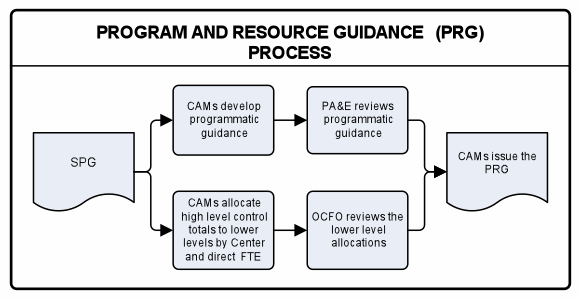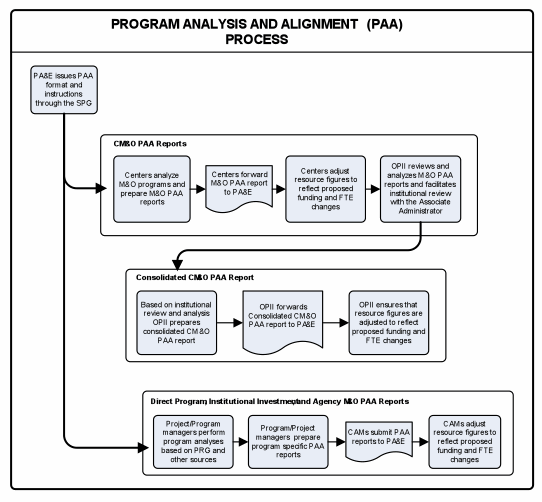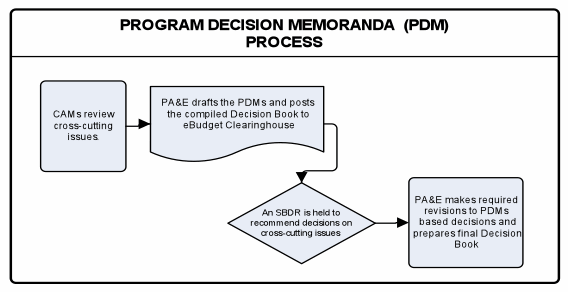Chapter 3. Programming
3.1 Overview
3.1.1 The Programming Phase encompasses the definition and analysis of programs and projects, together with their multi-year resource implications, and the evaluation of possible alternatives, including a risk assessment of each option. Programming also serves to balance and integrate resources among the various programs according to identified priorities.
3.2 Program and Resource Guidance (PRG)
3.2.1 Purpose. In this step, the CAMs take the Strategic Planning Guidance (SPG) and translate it into programmatic guidance and provide additional guidance for the program/project managers and the Centers. The PRG includes preliminary controls at the project by Center level for funding and for direct full-time equivalents (FTE) (to be used by the program/project managers as the basis for their alignment, re-planning, and issue analyses). The CAMs are expected to integrate any guidance that their programs/projects/mission support offices request to prevent the Centers from receiving multiple and conflicting guidance.
3.2.2 Process. The CAMs review the SPG and determine what programmatic level guidance needs to be issued to allow program/project managers and Centers to develop their program analysis and alignment reports. CAMs also allocate the high-level resource control totals from the SPG to lower funding details at levels that they believe appropriate by Center and the direct FTE program/project by Center. These FTE are a departure point for subsequent discussions rather than control totals. These initial allocations in the PRG do not change the base, but the resource figures will be updated during subsequent steps to reflect adjustments recommended and approved. CAMs track and explain all changes from the SPG control totals. Functional offices include any cross-cutting data calls in the PRG. PA&E ensures that programmatic guidance is consistent with the strategic guidance, and the OCFO ensures that resource allocations reconcile to the high-level resource control totals in the SPG. An illustration of the PRG process is provided in Figure 3-1.

Figure 3-1, PRG Process
3.2.3 Timeline. The CAMs may submit a draft PRG before the SPG is approved. The CAMs release their final PRG just after the issuance of the SPG.
3.2.4 PRG Responsibilities.
3.2.4.1 CAMs. Develop programmatic guidance within the strategic guidelines in the SPG. Allocate the SPG funding control totals down to lower levels but no lower than total project by Center, and identify direct FTE by program/project by Center. Track and explain all changes from the SPG control totals. Post the PRG to eBudget Clearinghouse. Integrate all Program/Project/Mission Support Offices guidance to avoid multiple and conflicting guidance at the Centers.
3.2.4.2 OCFO. Review CAM allocations to ensure compliance with resource control totals in the SPG. Define requirements for tracking subsequent adjustments to resource figures.
3.2.4.3 PA&E. Review CAM programmatic guidance to ensure compliance with the strategic guidance in the SPG.
3.3 Program Analyses and Alignment (PAA)
3.3.1 Purpose. In this step, CAMs identify what they intend to accomplish with their programs/projects to achieve Agency strategic objectives, identify any surplus or deficit capabilities and capacities, and identify the impact of funding reductions or any need for funding increases. The PAA report establishes the CAMs’ recommended strategy for the five-year budget period, projects that go into future years, demonstrates how planned programs will achieve Agency strategic objectives within allocated resource levels, develops performance commitment products for the performance budget submission, and includes issue papers as needed. It is used as the basis for PA&E’s program analysis of each control account, including support costs. (Institutional infrastructure analysis is conducted during the PAA.)
3.3.2 Process. PA&E issues instructions in the SPG regarding the content, format, and schedule for submission of the PAA report.
3.3.2.1 Center PAA/Integrated CM&O PAA. Centers analyze their M&O programs, complete the required formats and narratives, and submit the Center PAAs in eBudget Clearinghouse for the CM&O CAM and PA&E to review. As part of this process, Centers also adjust the resource figures to reflect proposed funding and FTE changes from the PRG. The CAM office for CM&O facilitates an institutional review with the Associate Administrator and other senior managers to communicate Center issues and recommendations to resolve those issues. The management decisions are combined with the Center PAAs by OPII to develop a Consolidated CM&O PAA report that includes adjusted resource and FTE totals, which his then forwarded to PA&E.
3.3.2.2 Mission Directorates, Office of Education, AM&O, and Institutional Investment PAA. Program/project managers, under the direction of the Mission Directorates, use the program/project-level information in the PRG as the basis for analyses of existing programs. They also solicit information from various staff members, including program analysts, Centers, and other field staff. Program/project managers analyze inputs and, as directed by the Mission Directorates, prepare a program-specific PAA report with the required information for PA&E to analyze various program funding scenarios and the impact of those scenarios on a program’s ability to achieve NASA strategic objectives. Some items that could be included in the report are program description, description of missing or surplus capabilities, information on unfunded requirements, analysis of the impact of PA&E defined funding scenarios, risk assessment of the various funding scenarios, discussion of alternatives considered but not taken, and description of the institutional and infrastructure impact on Centers based on increased or decreased resources. The PAA report may identify funding and FTE adjustments and rationales. CAMs also adjust the resource figures to reflect their proposed funding and FTE changes from the PRG. Program/project managers and Centers may also begin to establish agreements with service providers in this step. CAMs submit the PAA reports to PA&E for an initial review.
3.3.3 An illustration of the PAA process is provided in Figure 3-2.

Figure 3-2, PAA Process
3.3.4 Timeline. This step begins as soon as the SPG and PRG have been issued. The Center PAA reports are completed in March, and the CAM PAA reports are completed in mid-May for PA&E to analyze these reports and complete in June.
3.3.5 PAA Responsibilities.
3.3.5.1 CAMs. Complete the PAA reports for all assigned programs, coordinating the efforts of program/project managers. Adjust and explain adjustments to resource figures to reflect proposed funding and FTE changes from the PRG. Submit in eBudget Clearinghouse the PAA report and any outstanding issues.
3.3.5.2 CM&O CAM. Review submitted Center PAA reports to ensure that resource figures are correct and accurately reflect decisions concerning institutional integration. Facilitate a Mission Support Institutional Review with the Center Directors and CAMs with the Associate Administrator chairing. Develop a Consolidated CM&O PAA report and issue papers, as needed, and submit to PA&E.
3.3.5.3 Centers. Provide information and support to CAMs as requested. Complete the Center PAA reports and submit in eBudget Clearinghouse for CM&O CAM to review. Adjust and explain adjustments to resource figures to reflect proposed funding and FTE changes from the PRG. Continue ongoing discussions with program/project managers.
3.3.5.4 OCFO. Review completed PAA reports to ensure that resource figures are correct and that they reflect proposed funding and FTE changes from the SPG/PRG.
3.3.5.5 PA&E. Include the PAA report instructions in the SPG during that step. Review and assess submitted PAA reports for completeness, identification of issues, and alternative approaches for resolution. Develop a portfolio analysis and develop issue papers as required. Schedule PAA reviews, as needed.
3.4 Agency Issues Book
3.4.1 Purpose. In this step, PA&E reviews and analyzes all of the PAA and issue reports to ensure compliance with the SPG and the PRG, ensure that programs can achieve NASA’s strategic goals in the timeline indicated and with the resources identified, balance the needs of the various Mission Directorates with resources available, achieve strategic balance between programmatic and institutional needs, balance the capabilities and capacities of the various Centers, ensure that non-critical issues are resolved and documented, and identify critical issues that need to be brought to the SMC for discussion.
3.4.2 Process. PA&E reviews and analyzes the PAA reports and issue papers to determine if CAM proposals are the “best” uses of available capabilities and capacities within expected resource levels. As needed, PA&E contacts CAMs for clarification or additional information, or for CAMs to perform additional analyses and provide information on a new funding scenario. When PA&E reviews each issue paper, they add additional analysis and trade space as needed, along with making a recommendation. PA&E will also develop new issue papers if needed after reviewing all PAA reports. All issue papers submitted to PA&E or written by PA&E are provided to all affected offices so that they have an opportunity to add the CAM recommendation and comments. PA&E compiles the issue papers in an Agency Issues Book. Each issue paper includes the issue statement, discussion, resources required, alternatives, and recommendations. PA&E releases a draft Agency Issues Book through the eBudget Clearinghouse for review and further comment by CAMs. PA&E then submits to the SMC a final Agency Issues Book that presents the issues and recommendations and reflects any changes identified. Cross cutting issues and recommendations are briefed to the CAMs in a separate review to obtain decisions. Throughout this entire step, there is continuous communication among all parties. An illustration of the Agency Issues Book process is provided in Figure 3-4.

Figure 3-4, Agency Issues Book Process
3.4.3 Timeline. The draft Agency Issues Book is released to eBudget Clearinghouse mid to late June, and the final Issues Book is released late June or early July.
3.4.4 Agency Issues Book Responsibilities.
3.4.4.1 CAMs. Submit issue papers with PAA reports. Respond to issue paper questions. Review and comment on the draft Issues Book.
3.4.4.2 OCFO. Respond to issue paper questions. Review and comment on draft Issues Book.
3.4.4.3 PA&E. Analyze all information provided in the PAA reports. Review each issue paper and add additional analysis and trade space, along with recommendations. Develop new issue papers, as needed, after reviewing all PAA reports and issue papers, and provide to all affected offices so that they have an opportunity to add their CAM recommendation and comments. Compile the issue papers in an Agency Issues Book and coordinate the issue papers with all affected parties for comment. Release a draft Agency Issues Book through the eBudget Clearinghouse for review and further comment. Develop a final Issues Book that reflects any other changes identified, and present the issues and recommendations to the SMC for discussion. Present cross-cutting issues to the CAMs in a special review to obtain decisions.
3.5 Program Decision Memorandum (PDM)
3.5.1 Purpose. In this step, all of the Programming Phase decisions made to establish resource levels and FTE control totals for subsequent development of the budget are documented.
3.5.2 Process. PA&E presents to the CAMs and their resource staff any Agency cross-cutting issues to obtain decisions. PA&E then develops PDMs to document the decisions, which include the main points from the issue papers. PA&E obtains approval from the NASA Administrator or his or her designee for each PDM and compiles the PDMs into a Decision Book, which is posted to the eBudget Clearinghouse. In the event that there is a revision to a PDM or a new PDM is written, an addendum will be posted to the eBudget Clearinghouse. PA&E sets up a meeting, known as the Strategic Budget Decision Review (SBDR) to discuss cross-cutting issues and make recommendations to obtain decisions. PDMs are written to document the decisions from the SBDR. An illustration of the PDM process is provided in Figure 3-5.

Figure 3-5, PDM Process
3.5.3 Timeline. July to early August.
3.5.4 PDM Responsibilities.
3.5.4.1 CAMs. Review PDMs and take action. Attend SBDR to review and make recommendations for decisions on Agency cross-cutting issues and to approve draft PDMs.
3.5.4.2 OCFO. Review resource tables.
3.5.4.3 PA&E. Prepare PDM documentation, set up and present Agency cross-cutting issues and recommendations at the SBDR to obtain approvals on recommendations. Compile approved PDMs into a Decision Book and post to eBudget Clearinghouse.
3.5.4.4 NASA Administrator or Designee. Make final decisions on PDM issues
DISTRIBUTION:
NODIS
This Document is Obsolete and Is No Longer Used.
Check the NODIS Library to access the current version:
http://nodis3.gsfc.nasa.gov
![[NASA Logo]](../Images/nasaball.gif)



